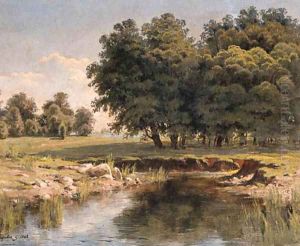Nikolai L'vovich Skadovskii Paintings
Nikolai L'vovich Skadovskii was a Russian and Soviet artist whose work spanned a critical transition period in Russian art, witnessing the twilight of the Russian Empire and the rise of the Soviet Union. Born in 1867, Skadovskii's career developed through a time of significant social, political, and artistic change. His early life and education were rooted in the traditions of 19th-century Russian art, but he would live to see and adapt to the avant-garde movements that revolutionized art in the early 20th century.
Skadovskii's artistic journey began in the Imperial Academy of Arts, where he honed his skills in painting and sculpture, aligning with the academic styles prevalent at the time. However, like many of his contemporaries, Skadovskii's style evolved, showing an increasing interest in the emerging movements of Symbolism, Impressionism, and later, elements of Expressionism. Despite this evolution, his work retained a distinct connection to Russian artistic traditions, often exploring themes of Russian folklore, history, and the natural landscape.
Throughout his career, Skadovskii navigated the complex political landscape of his time. The Russian Revolution of 1917 and the subsequent establishment of the Soviet Union dramatically altered the country's artistic scene. Artists were now faced with the challenge of aligning their work with the ideological demands of the new regime. Skadovskii managed to adapt to these changes, and his later works reflected the socialist realism style that became the official art form of the Soviet Union. Despite these shifts, his work remained deeply personal, characterized by a nuanced understanding of light, color, and form.
Nikolai L'vovich Skadovskii's death in 1937 marked the end of a career that spanned some of the most tumultuous and transformative decades in Russian history. His body of work serves as a vivid chronicle of this period, capturing the essence of Russian life and the spirit of its people through times of profound change. Skadovskii remains a significant figure in the history of Russian art, celebrated for his ability to blend traditional themes with the evolving artistic expressions of his time.
